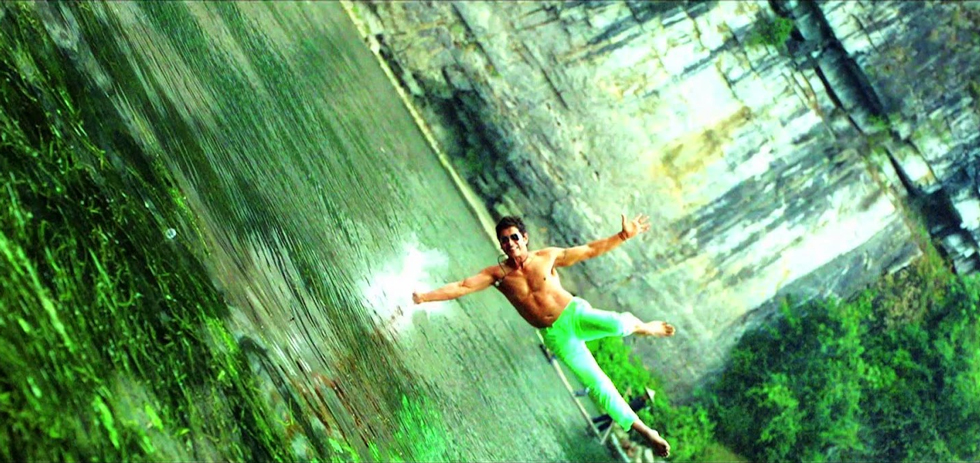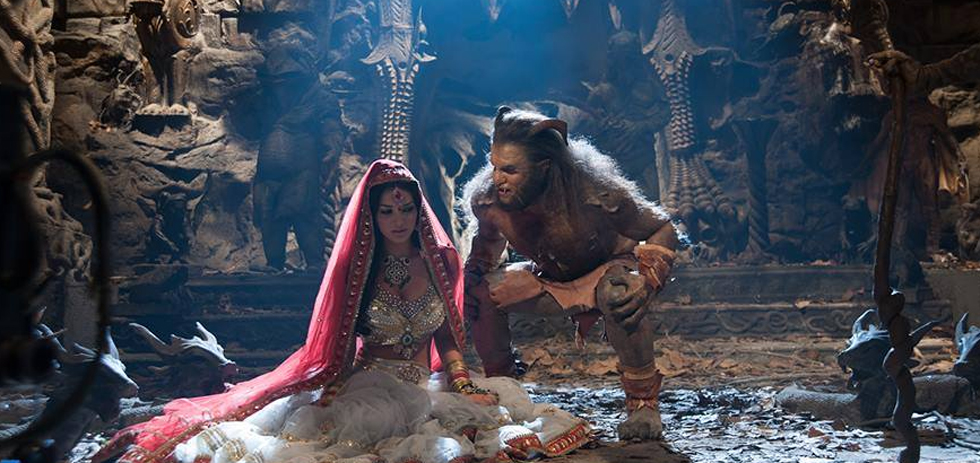
I is director Shankar’s concoction where Pygmalion meets Beauty and the Beast. Shankar has been responsible for popularising the theme of vigilantism in mainstream Tamil and Hindi cinema with box office successes such as Gentleman, Kadhalan, Indian, Mudhalvan/Nayak – and more recently, his immensely successful partnership with South Indian superstar Rajinikanth yielding films full of mass appeal such as Sivaji and Enthiran. With a record budget of 190 crores, one of the highest ever afforded to a director in the history of Indian cinema, expectations and curiosity were at their peak for his latest release – the minimally titled I. The title, though, is the only understated element of the whole film. Everything else – from the sets, locales, production values, the film’s running length and the overindulgence in the opulence of the male protagonist – happens on a grand scale, with Shankar attempting to justify every rupee of his magnanimous budget. The end result is an undoubtedly visually stunning product, marred by an ostensibly weak narrative and at 188 minutes running length, seriously tests the patience and sobriety of its audience.
I is an attempt to critique the obsession with form and physical appearance in the fashion industry while also deriding the rampant sexism that exists within the industry but goes unaddressed. The protagonist Lingesan (played with utmost sincerity and conviction by Vikram) is a bodybuilder who wants to win the ‘Mr Tamil Nadu’ title. He has only two obsessions – bodybuilding and a supermodel named Diya (played by the absolutely stunning Amy Jackson). Let’s say that this obsession is anything but healthy – where Lingesan goes to extreme lengths to buy any and every product that Diya endorses – from nightgowns to sanitary napkins!
On the other hand, Diya is one of India’s foremost supermodels struggling to stay at the top in a sexist and patriarchal industry. John (Upen Patel). Diya’s male model colleague constantly harasses her and wants her to sleep with him. After getting rebuked for the umpteenth time, John gets Diya blacklisted. Diya, who happens to meet Lingesan, devises her own way of fighting back against institutionalised sexism. She transforms Lingesan from an uncouth body builder into a sophisticated male model, rechristening him ‘Lee’ and using him to complete her remaining projects. ‘Lee’ takes the fashion industry by storm and soon rises to the top of the industry. Diya in the process falls in love with her Galatea – Lingesan aka Lee – after initially only intending to use him to get herself back to her rightful place in the fashion industry. Lee and Diya’s professional and personal relationship soon becomes the talk of the town. However, in his meteoric rise to the top, Lingesan makes many unintended enemies who all want revenge. Lingesan’s enemies use an exceptionally cruel method to destroy Lingesan and separate him from Diya. How Lingesan goes on to take revenge on those who’ve wronged and gets Diya back forms the rest of the narrative.
Firstly, let’s look at the positives, and there are some. The film is an implied commentary on the fashion industry in India and is critical of its entrenched sexism. To be honest, I wasn’t expecting any social commentary, so it was refreshing to see. The way the film revolves around humanity’s obsession with outer appearance is really the focal point that drives the narrative.
Why just the fashion industry? A lot of mainstream, commercial Indian cinema is male oriented as well.1 Indian male celebrities have a massive, loyal fanbase and many of them are bankable commodities based on whose commercial success films are marketed. In such films, female actors often just fulfil a ‘filler’ role or play a generic love interest as per the demands of the narrative. I’m not saying this is always the case, but it is unfortunately, not uncommon. Hence, it was a step in the right direction to see Diya’s character stand up against sexism and not let her be reduced to just a romantic interest, even if the film ultimately becomes Lingesan’s revenge story.

P.C. Sreeram’s cinematography is magnificent. He lights up every frame, making the film a visual treat and an aesthetic experience. The visual presentation of the film, despite its 188 minutes runtime, meant that I always had a smile on my face. Despite all its flaws, I will admit that this was a truly beautiful film to see. The vibrant way in which it’s shot enhances the contrasting colour schemes. The costumes of the two protagonists often match the scenic background locations, most commonly during music interludes and song sequences. It most definitely is a visual spectacle.
It’s no secret that song sequences form a huge part of Indian films – a factor that often attracts or alienates foreign audiences to Indian cinema. I’m delighted to note that ‘I’ didn’t turn out to be one of those films where the song sequences hampered the narrative. In fact, the song sequences are actually the most innovative aspect of the film. I haven’t seen such creative picturisation of song sequences in recent times (except may be in films by Anurag Kashyap). There’s a song which is basically a collection of snippets of advertisements that Diya and ‘Lee’ shoot for together. There’s yet another where Lingesan’s obsession for Diya manifests itself in highly unusual and slightly creepy ways. But the best of the lot definitely has to be the sequence where Lingesan essentially is dressed up as a character similar to The Beast and Diya presented as The Beauty. Not great in terms of subtlety, but exceptional in terms of visual grandeur. Music is by Oscar winner and international sensation A.R. Rahman is also decent, but not great. Rahman and director Shankar have combined in the past to give some memorable tunes, but this score doesn’t quite reach their high standards.2
However, despite the visual spectacle, you cannot look past the fact that the narrative is wholly predictable and the direction lethargic. The viewer knows early on that this is going to be a revenge story and there are absolutely no twists or turns along way. This makes the 188 minutes excruciatingly painful to sit through, even though what unfolds looks visually pleasant.
Another painful aspect of the film was the negative characterisation of a character which appeared to be of a transgender orientation.3 There is a damning history of misrepresentation and/or trivialisation or the LGBTIQ in Indian cinema – and by that I mean all kinds of Indian cinema, be it Hindi, Telugu, Tamil and so on.4 All the good work that film does in its social commentary against sexism and obsession over physical beauty is ruined by this harrowing trivialisation. It’s just an indicator that mainstream Indian cinema still has a lot of growing up to do when it comes to handling complex social issues and inclusive representation of people from different communities.
So your best bet? Watch the song sequences of the film on YouTube. They’re easily the most creative and engaging aspect of the film, with all the visual splendour preserved in each frame. Avoid the lengthy sentence of sitting through 188 minutes of expected narrative tropes.
